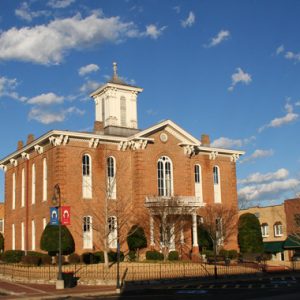calsfoundation@cals.org
Pocahontas Commercial Historic District
The Pocahontas Commercial Historic District is the historic downtown area of Pocahontas (Randolph County). This area has been the seat of local and county government, as well its commercial center, since the formation of the county in 1836. The commercial district is roughly bounded by Thomasville, Jordan, Broadway, and Vance streets. The downtown area comprises numerous historic buildings, including two courthouses, a service garage, a theater, a Works Progress Administration (WPA) post office, and the former city hall and city-function buildings, as well as other buildings currently utilized for modern business purposes. Both of the courthouses and the WPA post office are individually listed on the National Register of Historic Places. The center of the commercial district is dominated by the 1875 Old Randolph County Courthouse, and the downtown area represents the architectural history of late nineteenth- and early twentieth-century Pocahontas.
Pocahontas is located on the edge of the Ozark Foothills and the edge of the Mississippi Alluvial Plain. The commercial district is just a short distance away from Black River, which allowed steamboat traffic to play an important role in the economic history of Pocahontas. Agricultural products from both geographic areas spurred the business activity of the Pocahontas area, which allowed for the growth of a dominant commercial district. As with other steamboat towns, Pocahontas declined as the region transitioned from steamboat traffic to railroads. However, the town soon prospered when the St. Louis–San Francisco Railway created a branch line from Hoxie (Lawrence County) to Pocahontas in the 1890s; this rail connection was compounded when another rail line was expanded from Pocahontas to Cape Girardeau, Missouri, in 1902–1903. The line to Cape Girardeau also created a bridge to the eastern portion of Randolph County, which had previously been serviced primarily by ferries.
In the 1930s, three Civilian Conservation Corps (CCC) camps were built in Randolph County to assist the depressed economy. The CCC, along with numerous WPA projects, constructed waterworks, a hospital, highways (including an expansion of U.S. Highway 67), a post office, and a new county courthouse. The economic history of Pocahontas, including the historic commercial district, has been dependent on goods traveling on steamboats, railroads, and asphalt highways; the only one of these left servicing the town is the modern highway system.
The majority of the historical buildings are built of brick with flat roofs. Many of the buildings were designed by the same German architect, Henry Lesmeister, and constructed using similar materials from the surrounding area. The buildings represent Italianate, Classical Revival, Art Deco, and Art Moderne with stylistic elements including parapets, brick corbelling, soldier courses, decorative brickwork, and occasional arched windows or storefront columns or pilasters. They are also indicative of a major settlement pattern by German immigrants to the Pocahontas area. A fire in 1914 destroyed a number of buildings in the commercial district, and some buildings today have been modified. However, the commercial district retains remarkable integrity. The Pocahontas Commercial Historic District was added to the National Register of Historic Places on June 12, 2009.
For additional information:
Cook, Regina, et al. History of Randolph County, Arkansas. Dallas: Curtis Media Corp., 1992.
Dalton, Lawrence. History of Randolph County. Little Rock: Democrat Printing and Lithographing Company, 1946.
Dougan, Michael B. “The Doctrine of Creative Destruction: Ferry and Bridge Law in Arkansas.” Arkansas Historical Quarterly 39 (Summer 1980): 136–158.
The Goodspeed Biographical and Historical Memoirs of Northeast Arkansas. Chicago: Goodspeed Publishing Co., 1889.
“Pocahontas Commercial Historic District.” National Register of Historic Places nomination form. On file at Arkansas Historic Preservation Program, Little Rock, Arkansas. Online at http://www.arkansaspreservation.com/National-Register-Listings/PDF/RA0079.nr.pdf (accessed October 22, 2020).
Zachary Elledge
Jonesboro, Arkansas
 Architectural Styles
Architectural Styles Historic Preservation
Historic Preservation Randolph County Courthouse
Randolph County Courthouse  Randolph County Courthouse
Randolph County Courthouse 




Comments
No comments on this entry yet.